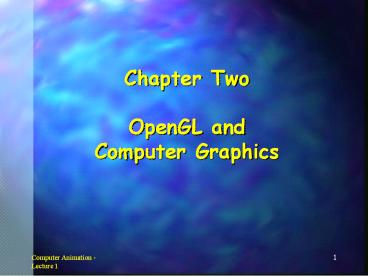Chapter Two OpenGL and Computer Graphics PowerPoint PPT Presentation
Title: Chapter Two OpenGL and Computer Graphics
1
Chapter TwoOpenGL and Computer Graphics
2
What is OpenGL?
- A software interface to graphics hardware or
- Provides a hardware abstraction layer, through
its Applications Programmer Interface (API) - A 3D graphics and modeling library that is
extremely portable and very fast
3
What is OpenGL?
- Provides low level, platform independent graphics
- Allows non-standard extensions
- Does not provide windowing facilities (we use
GLUT for that) - Is a largely an immediate mode graphics library
- We would have to write our own higher level
retained mode library
4
OpenGL Primitives
- OpenGL uses only a very small number of
primitives - Points,
- Lines
- Polygons
- Bitmaps/images
- Three primitives are then passed through
- The lighting/shading algorithms
- The 3D viewing algorithms
- And finally rasterisation (scan conversion)
5
GLUT
- OpenGL Utilities Toolkit
- Provides us with a basic window and interaction
management system - glutInit(argc, argv) initialise GLUT
- glutInitDisplayMode(GLUT_SINGLEGLUT_RGB) allows
us to set up the way OpenGL will run - Can create and position, size and name a window
- Callbacks provide event(interrupt) driven
interaction with keyboard, mouse, display and
resizing - Callback functions must receive the specified
parameters
6
Basic OpenGL
- The basic command is glVertex_at_
- defines the number of coordinates we will give
generally 2, 3, or 4 - _at_ defines what type the arguments are. The most
common type - i for int (GLint)
- f for float (GLfloat)
- d for double (GLdouble)
- Other OpenGL commands such as glColor_at_,
glRasterPos_at_, glNormal_at_ also have this syntax - An additional v may be specified at the end if we
want to pass an array (vector)
7
Drawing with OpenGL
- The way the primitives are drawn on screen is
determined by the drawing mode - glBegin(mode) and glEnd() must always enclose
calls to glVertex_at_ - The drawing mode can be
- GL_POINTS
- GL_LINES
- GL_LINE_STRIP
- GL_TRIANGLES
- GL_QUADS
- GL_POLYGON
8
Colour and OpenGL
- Before drawing, clear the screen buffer using
glClear with option GL_COLOR_BUFFER_BIT - Set the background colour using glClearColor(0.0,
0.0, 0.0, 0.0) - Set the color of the vertices using glColor_at_ -
note each vertex can be a different colour - We always use RGB colours, for different types we
have - f and d take 0.0 to 1.0
- ub takes 0 to 255
9
Styles and OpenGL
- The way polygons are drawn can be set using
glPolygonMode which applies to either
face(GL_FRONT or GL_BACK) and can be - GL_POINT
- GL_LINE
- GL_FILL
10
Styles and OpenGL
- Lines can be styled using glLineWidth(Glfloat
width), and glLineStipple(Glint factor, Glushort
pattern) - Points can be changed in size using
glPointSize(Glfloat size) - This is really for basic 2D drawing
11
Controlling OpenGL
- Glflush() causes OpenGL to flush to the screen
buffer draw the image - When animating, use glutSwapBuffers() and the
double buffer mode, giving smoother animation - GLUT also provides us with a glutIdleFunction
which contains the animation routine which
typically calls glutPostRedisplay() - Sometimes we use global variables to control the
animation (if we havent produced a higher level
scene graph) - Make them static and use with care
12
Output Primitives
- Points
- Attributes Size, Color.
13
Output Primitives
- Lines
- Attributes Color, Thickness, Type
14
Output Primitives
- Polylines (open)
- A set of line segments joined end to end.
- Attributes Color, Thickness, Type
15
Output Primitives
- Polylines (closed)
- A polyline with the last point connected to the
first point . - Attributes Color, Thickness, Type
Note A closed polyline cannot be filled.
16
Output Primitives
- Polygons
- A set of line segments joined end to end.
- Attributes Fill color, Thickness, Fill pattern
Note Polygons can be filled.

